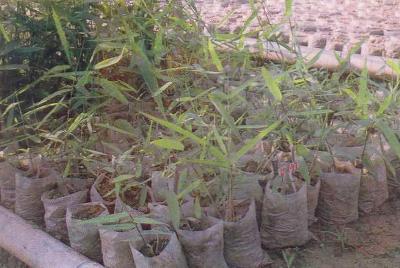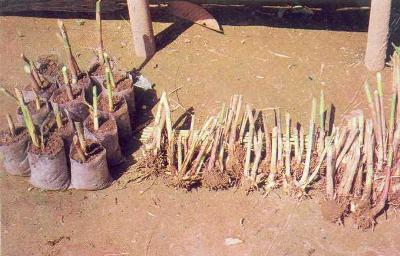Shimanta kr. Goswami
The aims of this project is to employ villagers otherwise engaged in forest destruction in the plantation of two cash crops in the abandoned croplands which will also wean them away from the traditional but less economically viable slash and burn method.
Secondly, to establish the socio-economic and land use patterns of the forest villagers to enable the preparation of future conservation action plan and target specific areas for anti-poaching and elephant habitat management activities.

Polybag seedlings of broom-grass.
The project envisages utilization of abandoned crop fields from earlier years for productive cultivation. The utilization of the many abandoned crop fields for plantation of two cash crops is expected to wean away a majority of the villagers in the four selected villages from the traditional slash and burn cultivation. The slash and burn method is responsible for the destruction of large tracts of forests and up to 10 to 12 hectares of forest land cleared by each small village every year can be saved. The sum total of forests saved from destruction each year by inhabitants of targeted villages will significantly contribute to conservation of the natural habitat.

Rhizome cuttings in polythene bags, and rhizome - cuttings ready for plantation.
The villagers will be engaged in cultivation throughout the year as the two cash crops are harvested at different times in the year. The introduction of two cash crops, namely Pigeon Pea and Green Gram grown simultaneously but harvested at different periods in a year, will contribute significantly to the socio-economic betterment of the villagers. The Pigeon Pea shrub once planted needs little maintenance and can be harvested yearly up to the third year. It is unpalatable to the elephants and the shrubs are used as firewood. The Green Gram climbers can be planted along with the Pigeon Pea shrubs and is harvested four months after plantation. Both these crops have a good market value and not perishable. The provision of these viable, alternate livelihoods is expected to arrest the tendency of poor unemployed villagers to engage in logging and poaching activities. The success of these activities in the selected villages will create goodwill and generate interest in neighbouring villages. The expansion of these activities beyond the four targeted villages and abandonment of the traditional slash and burn method in favour of these more productive and environment friendly activities will contribute significantly to long-term conservation of the dense natural forests of the East Karbi hills.
The proposed survey of selected human settlements will establish the socio-economic condition and land use pattern of the forest villagers and facilitate future development activities for them. The results will enable the preparation of future conservation action plan and target specific areas for anti poaching and elephant habitat management activities.
An expected key outcome in the long run is the decrease of elephant incursions into human
settlements in the foothills and bordering areas due to better preservation of the elephant habitat in the East Karbi hills.